Kaist
Korean

News
College of Engineering News
-

Multi-Device Mobile Platform for App Functionality..
Case 1. Mr. Kim, an employee, logged on to his SNS account using a tablet PC at the airport while traveling overseas. However, a malicious virus was installed on the tablet PC and some photos posted on his SNS were deleted by someone else. Case 2. Mr. and Mrs. Brown are busy contacting credit card and game companies, because his son, who likes games, purchased a million dollars worth of game items using his smartphone. Case 3. Mr. Park, who enjoys games, bought a sensor-based racing game through his tablet PC. However, he could not enjoy the racing game on his tablet because it was not comfortable to tilt the device for game control. The above cases are some of the various problems that can arise in modern society where diverse smart devices, including smartphones, exist. Recently, new technology has been developed to easily solve these problems. Professor Insik Shin from the School of Computing has developed ‘Mobile Plus,’ which is a mobile platform that can share the functionalities of applications between smart devices. This is a novel technology that allows applications to easily share their functionalities without needing any modifications. Smartphone users often use Facebook to log in to another SNS account like Instagram, or use a gallery app to post some photos on their SNS. These examples are possible, because the applications share their login and photo management functionalities. The functionality sharing enables users to utilize smartphones in various and convenient ways and allows app developers to easily create applications. However, current mobile platforms such as Android or iOS only support functionality sharing within a single mobile device. It is burdensome for both developers and users to share functionalities across devices because developers would need to create more complex applications and users would need to install the applications on each device. To address this problem, Professor Shin’s research team developed platform technology to support functionality sharing between devices. The main concept is using virtualization to give the illusion that the applications running on separate devices are on a single device. They succeeded in this virtualization by extending a RPC (Remote Procedure Call) scheme to multi-device environments. This virtualization technology enables the existing applications to share their functionalities without needing any modifications, regardless of the type of applications. So users can now use them without additional purchases or updates. Mobile Plus can support hardware functionalities like cameras, microphones, and GPS as well as application functionalities such as logins, payments, and photo sharing. Its greatest advantage is its wide range of possible applications. Professor Shin said, "Mobile Plus is expected to have great synergy with smart home and smart car technologies. It can provide novel user experiences (UXs) so that users can easily utilize various applications of smart home/vehicle infotainment systems by using a smartphone as their hub." This research was published at ACM MobiSys, an international conference on mobile computing that was hosted in the United States on June 21. < Figure1. Users can securely log on to SNS accounts by using their personal devices > < Figure 2. Parents can control impulse shopping of their children. > < Figure 3. Users can enjoy games more and more by using the smartphone as a controller >
-

Analysis of Gas Adsorption Properties for Amorphou..
Professor Jihan Kim from the Department of Chemical and Biomolecular Engineering at KAIST has developed a method to predict gas adsorption properties of amorphous porous materials. Metal-organic frameworks (MOFs) have large surface area and high density of pores, making them appropriate for various energy and environmental-related applications. And although most MOFs are crystalline, these structures can deform during synthesis and/or industrial processes, leading to loss in long-range order. Unfortunately, without the structural information, existing computer simulation techniques cannot be used to model these materials. In this research, Professor Kim’s research team demonstrated that one can replace the material properties of structurally deformed MOFs with those of crystalline MOFs to indirectly analyze/model the material properties of amorphous materials. First, the team conducted simulations on methane gas adsorption properties for over 12,000 crystalline MOFs to obtain a large training set data, and created a resulting structure-property map. Upon mapping the experimental data of amorphous MOFs onto the structure-property map, results showed that regardless of crystallinity, the gas adsorption properties of MOFs showed congruence and consistency amongst one another. Based on these findings, selected crystalline MOFs with the most similar gas adsorption properties as the collapsed structure from the 12,000 candidates. Then, the team verified that the adsorption properties of these similar MOFs can be successfully transferred to the deformed MOFs across different temperatures and even to different gas molecules (e.g. hydrogen), demonstrating transferability of properties. These findings allow material property prediction in porous materials such as MOFs without structural information, and the techniques here can be used to better predict and understand optimal materials for various applications including, carbon dioxide capture, gas storage and separations. This research was conducted in collaboration with Professor Dae-Woon Lim at Kyoto University, Professor Myunghyun Paik at Seoul National University, Professor Minyoung Yoon at Gachon University, and Aadesh Harale at Saudi Arabian Oil Company. The research was published in the Proceedings of the National Academy of Sciences (PNAS) online on 10 July and the co-first authors were Ph. D. candidate WooSeok Jeong and Professor Dae-Woon Lim. This research was funded by the Saudi Aramco-KAIST CO2 Management Center. < Figure 1. Trends in structure - material property map and in collapsed structures > < Figure 2. Transferability between the experimental results of collapsed MOFs and the simulation results of crystalline MOFs >
-
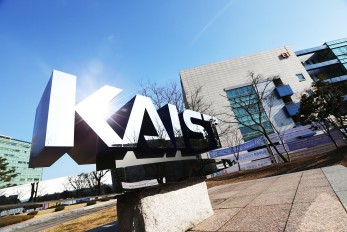
[Geek] Korean Students Invited to Build AI Soccer ..
● https://www.geek.com/tech/korean-students-invited-to-build-ai-soccer-players-1707322 We know artificial intelligence can outsmart humans at an abstract strategy board game. But can it bend it like Beckham? The Korea Advanced Institute of Science and Technology (KAIST) this week announced an upcoming AI soccer tournament for university students. Scheduled for November, the competition will include three machine-powered aspects: gameplay, analysis, and reporting, according to The Korea Times. Teams of five artificial players?four outfielders, one goalkeeper?will face off against each other in a series of preliminary matches. The final winner is set to be crowned on Dec. 1. KAIST is going full-ESPN, though, with the introduction of a game analysis contest, in which the neural network that creates “the most accurate … commentary” during matches wins a prize. The same goes for the AI reporter that pens the best post-match results “in a news-writing format,” the Times said. This fall’s event is a world first, according to KAIST, which encourages all local college and graduate school students to participate (applications are open through September). Famous for running an annual international robot soccer competition for the public since the mid-’90s, the academy is now turning its attention the next generation of creators. And assuming all goes well, the Institute promised to invite foreign clubs to next year’s tourney. “Overseas teams will be able to participate in the AI [soccer] matches next year, and we expect the tournament to become an internationally renowned tech event in the future,” computer engineering professor Kim Jong-hwan, president of KAIST’s AI World Cup Committee, told The Korea Times. The original International Micro Robot World Cup Soccer Tournament (MIROSOT)?now formally called RoboCup?was born in KAIST’s Robot Intelligence Technology Lab in 1995. An American team from Newton Labs won the first competition, held in Taejon, Korea, in November 1996. The Federation of International Robot-soccer Association (FIRA) was established two years later, just ahead of 1998’s International Robot Olympiad Committee (IROC), formed for the World Robot Olympiad.
-
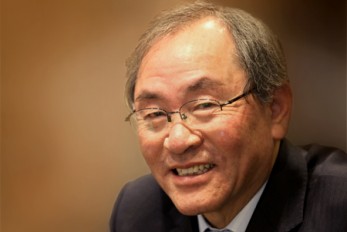
Professor Nam Jin Cho Selected as the Eugene P. Wi..
〈 Prof. Nam Jin Cho 〉 Professor Nam Jin Cho from the Department of Nuclear & Quantum Engineering was selected as the recipient of the 2017 ‘Eugene P. Wigner Reactor Physicist Award.’ The award, established in 1990 by the American Nuclear Society, honors individuals who have made outstanding contributions to the advancement of the field of reactor physics. The award is named after the late Eugene P. Wigner, a pioneer who helped nurture the nuclear age to technical maturity with his pioneering leadership in reactor design. Professor Cho was recognized for his outstanding leadership and achievement in the field of nuclear physics, especially with his original research in analytic function expansion nodal methods, coarse-mesh angular dependent rebalance methods, and neutron transport calculations. A fellow of the ANS, Professor Cho is the first awardee from the Asian region. Professor Cho gave all the credit to his colleagues and students at KAIST who have spared no effort while working together for three decades. “I am very grateful for the unique academic ambience which made this challenging work possible as well as the government’s continuing funding at the National Research Laboratory project.
-

[Biz&Tech] KAIST to hold AI football tournament
By Lee Min-hyung The Korea Advanced Institute of Science and Technology (KAIST) said it will hold an artificial intelligence (AI) football tournament using an online simulation framework in November. The nation's leading technology institute said Tuesday that it will hold three AI-powered events football matches, game analysis and post-match news writing. To be specific, each team will consist of five players for the AI football matches. For the game analysis competition, those who create the most accurate analysis and commentary during the matches will win a prize. The AI reporter event participants will have to write post-match results in a news-writing format. "The football matches will be conducted in a five on five tournament. Each of the five AI-programmed players in such positions as striker, defender and goalkeeper will compete with their counterparts," a KAIST official said. The university will hold preliminary matches in November, with the final winner set to be announced on Dec. 1. Any college or graduate school student can apply for the tournament through the end of September. The AI-driven football tournament is a world first, according to KAIST. The university will invite foreign teams beginning next year. The institute is renowned for running an international robot football competition since 1996. The rise of AI and big data allowed KAIST to hold the new event this year. KAIST established what it calls the AI World Cup Committee last month, with professors from its major departments such as electronic engineering and industrial engineering playing a key role to prepare for the matches. KAIST said the event comes as part of its efforts to be in line with the upcoming Fourth Industrial Revolution by converging its technological expertise in such areas as the bio, nano, info-tech, robotics and AI fields. "Overseas teams will be able to participate in the AI football matches next year, and we expect the tournament to become an internationally-renowned tech event in the future," said Kim Jong-hwan, the president of the committee, who also serves as a professor of computer engineering at KAIST. ● http://www.koreatimes.co.kr/www/tech/2017/07/133_232786.html
-

[Aju Business Daily] Public research university KA..
South Korea's top public research university will host an artificial intelligence world cup among undergraduate and postgraduate students in November. The Korea Advanced Institute of Science and Technology (KAIST) said it would co-host the 24-day "AI world Cup 2017" on November 1 with its Machine Intelligence and Robotics Multi-Sponsored Research and Education Platform. Each team will compete in a simulated football game, using skills its AI program has learned. AI will be evaluated over commentary of the matches. Robot professionals will be tested over news articles they write after analyzing the games. Students at South Korean universities and post-university classes are eligible but KAIST will open the door for foreign students next year. Park Sae-jin = swatchsjp@ajunews.com Aju Business Daily & www.ajunews.com Copyright: All materials on this site may not be reproduced, distributed, transmitted, displayed, published or broadcast without the authorization from the Aju News Corporation. ● http://www.ajudaily.com/view/20170711171543103
-

Cooperative Tumor Cell Membrane-Targeted Photother..
〈 Prof. Ji-Ho Park 〉 A KAIST research team led by Professor Ji-Ho Park in the Bio and Brain Engineering Department at KAIST developed a technology for the effective treatment of cancer by delivering synthetic receptors throughout tumor tissue. The study, led by Ph.D. candidate Heegon Kim, was published online in Nature Communications on June 19. Cancer targeted therapy generally refers to therapy targeting specific molecules that are involved in the growth and generation of cancer. The targeted delivery of therapeutics using targeting agents such as antibodies or nanomaterials has improved the precision and safety of cancer therapy. However, the paucity and heterogeneity of identified molecular targets within tumors have resulted in poor and uneven distribution of targeted agents, thus compromising treatment outcomes. To solve this problem, the team constructed a cooperative targeting system in which synthetic and biological nanocomponents participate together in the tumor cell membrane-selective localization of synthetic receptors to amplify the subsequent targeting of therapeutics. Here, synthetic and biological nanocomponents refer to liposomes and extracellular vesicles, respectively. The synthetic receptors are first delivered selectively to tumor cell membranes in the perivascular region using liposomes. By hitchhiking with extracellular vesicles secreted by the cells, the synthetic receptors are transferred to neighboring cells and further spread throughout the tumor tissues where the molecular targets are limited. Hitchhiking extracellular vesicles for delivery of synthetic receptors was possible since extracellular vesicles, such as exosomes, mediate intercellular communications by transferring various biological components such as lipids, cytosolic proteins, and RNA through a membrane fusion process. They also play a supportive role in promoting tumor progression in that tumor-derived extracellular vesicles deliver oncogenic signals to normal host cells. The team showed that this tumor cell membrane-targeted delivery of synthetic receptors led to a uniform distribution of synthetic receptors throughout a tumor and subsequently led to enhanced phototherapeutic efficacy of the targeted photosensitizer. Professor Park said, “The cooperative tumor targeting system is expected to be applied in treating various diseases that are hard to target.” The research was funded by the Basic Science Research Program through the National Research Foundation funded by the Ministry of Science, ICT & Future Planning, and the National R&D Program for Cancer Control funded by the Ministry for Health and Welfare. < Ph.D. candidates Hee Gon Kim (left) and Chanhee Oh > Figure 1. A schematic of a cooperative tumor targeting system via delivery of synthetic receptors. Figure 2. A confocal microscopic image of a tumor section after cooperative targeting by synthetic receptor delivery. Green and magenta represent vessels and therapeutic agents inside a tumor respectively.
-
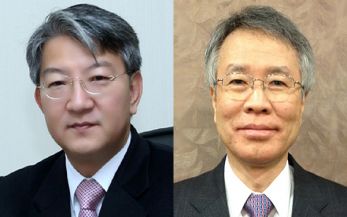
KAIST Professors Sweep the Best Science and Techno..
< Distinguished Professors Sang Yup Lee (left) and Kyu-Young Whang > Distinguished Professors Sang Yup Lee from the Department of Chemical and Biomolecular Engineering and Kyu-Young Whang of the College of Computing were selected as the winners of the "2017 Korea Best Science and Technology Award" by the Ministry of Science, ICT and Future Planning (MSIP) and the Korea Federation of Science and Technology Societies. The award, which was established in 2003, is the highest honor bestowed to the two most outstanding scientists in Korea annually. This is the first time that KAIST faculty members have swept the award since its founding. Distinguished Professor Lee is renowned for his pioneering studies of system metabolic engineering, which produces useful chemicals by utilizing microorganisms. Professor Lee has developed a number of globally-recognized original technologies such as gasoline production using micro-organisms, a bio-butanol production process, microbes for producing nylon and plastic raw materials, and making native-like spider silk produced in metabolically engineering bacterium which is stronger than steel but finer than human hair. System metabolism engineering was also selected as one of the top 10 promising technologies in the world in 2016 by the World Economic Forum. Selected as one of the world’s top 20 applied bioscientists in 2014 by Nature Biotechnology, he has many ‘first’ titles in his academic and research careers. He was the first Asian to win the James Bailey Award (2016) and Marvin Johnson Award (2012), the first Korean elected to both the US National Academy of Science (NAS) and the National Academy of Engineering (NAE) this year. He is the dean of KAIST institutes, a multi and interdisciplinary research institute at KAIST. He serves as co-chair of the Global Council on Biotechnology and as a member of the Global Future Council on the Fourth Industrial Revolution at the World Economic Forum. Distinguished Professor Whang, the first recipient in the field of computer science in this award, has been recognized for his lifetime achievement and contributions to the development of the software industry and the spreading of information culture. He has taken a pioneering role in presenting novel theories and innovative technologies in the field of database systems such as probabilistic aggregation, multidimensional indexing, query, and database and information retrieval. The Odysseus database management system Professor Hwang developed has been applied in many diverse fields of industry, while promoting the domestic software industry and its technical independence. Professor Hwang is a fellow at the American Computer Society (ACM) and life fellow at IEEE. Professor Whang received the ACM SIGMOD Contributions Award in 2014 for his work promoting database research worldwide, the PAKDD Distinguished Contributions Award in 2014, and the DASFAA Outstanding Contributions Award in 2011 for his contributions to database and data mining research in the Asia-Pacific region. He is also the recipient of the prestigious Korea (presidential) Engineering Award in 2012.
-
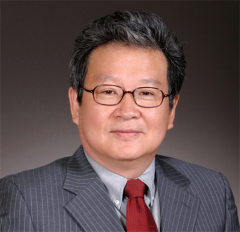
Professor Poong Hyun Seong Selected as Fellow of A..
〈 Prof. Poong Hyun Seong 〉 Professor Poong Hyun Seong of the Department of Nuclear and Quantum Engineering was selected as a fellow of the American Nuclear Society. The selection was announced at their annual meeting held in San Francisco on June 12, in recognition of Professor Seong's contributions to the field of nuclear instrumentation, control andhuman factors engineering. Founded in 1954, the American Nuclear Society selects scholars who have made outstanding achievements and contributions to the development of the nuclear engineering field each year. Professor Seong's researches in the field of nuclear instrumentation, control and human factors engineering have contributed to the safe operation of nuclear power plants, to the development of systems to maintain nuclear power plants safely in the event of emergency and to the enhancement of effective response capabilities of nuclear power plant operators. His researches significantly contributed to the safety improvement of nuclear power plants and have been recognized worldwide. Professor Seong said, "Korea has emerged as a nuclear powerhouse. I think not only my academic career but our national reputation in the field of nuclear research has been well recognized by our global peers.” Professor Seong has served as president of the Korean Nuclear Society, editor in chief of Nuclear Engineering and Technology, and as a commissioner of the Korean Nuclear Safety Commission. He is currently working as a commissioner of the Korean Atomic Energy Commission.
-

Why Don’t My Document Photos Rotate Correctly?
〈 The team of Professor Lee and his Ph.D.student Jeungmin Oh developed a technique that can correct a phone’s orientation by tracking the rotation sensor in a phone.) 〉 John, an insurance planner, took several photos of a competitors’ new brochures. At a meeting, he opened a photo gallery to discuss the documents with his colleagues. He found, however, that the photos of the document had the wrong orientation; they had been rotated in 90 degrees clockwise. He then rotated his phone 90 degrees counterclockwise, but the document photos also rotated at the same time. After trying this several times, he realized that it was impossible to display the document photos correctly on his phone. Instead, he had to set his phone down on a table and move his chair to show the photos in the correct orientation. It was very frustrating for John and his colleagues, because the document photos had different patterns of orientation errors. Professor Uichin Lee and his team at KAIST have identified the key reasons for such orientation errors and proposed novel techniques to solve this problem efficiently. Interestingly, it was due to a software glitch in screen rotation?tracking algorithms, and all smartphones on the market suffer from this error. When taking a photo of a document, your smartphone generally becomes parallel to the flat surface, as shown in the figure above (right). Professor Lee said, “Your phone fails to track the orientation if you make any rotation changes at that moment.” This is because software engineers designed the rotation tracking software in conventional smartphones with the following assumption: people hold their phones vertically either in portrait or landscape orientations. Orientation tracking can be done by simply measuring the gravity direction using an acceleration sensor in the phone (for example, whether gravity falls into the portrait or landscape direction). Professor Lee’s team conducted a controlled experiment to discover how often orientation errors happen in document-capturing tasks. Surprisingly, their results showed that landscape document photos had error rates of 93%. Smartphones’ camera apps display the current orientation using a camera-shaped icon, but users are unaware of this feature, nor do they notice its state when they take document photos. This is why we often encounter rotation errors in our daily lives, with no idea of why the errors are occurring. The team developed a technique that can correct a phone’s orientation by tracking the rotation sensor in a phone. When people take document photos their smartphones become parallel to the documents on a flat surface. This intention of photographing documents can be easily recognizable because gravity falls onto the phone’s surface. The current orientation can be tracked by monitoring the occurrence of significant rotation. In addition, the research team discovered that when taking a document photo, the user tends to tilt the phone, just slightly, towards the user (called a “micro-tilt phenomenon”). While the tilting degree is very small?almost indistinguishable to the naked eye?these distinct behavioral cues are enough to train machine-learning models that can easily learn the patterns of gravity distributions across the phone. The team’s experimental results showed that their algorithms can accurately track phone orientation in document-capturing tasks at 93% accuracy. Their approaches can be readily integrated into both Google Android and Apple iPhones. The key benefits of their proposals are that the correction software works only when the intent of photographing documents is detected, and that it can seamlessly work with existing orientation tracking methods without conflict. The research team even suggested a novel user interface for photographing documents. Just like with photocopiers, the capture interface overlays a document shape onto a viewfinder so that the user can easily double-check possible orientation errors. Professor Lee said, “Photographing documents is part of our daily activities, but orientation errors are so prevalent that many users have difficulties in viewing their documents on their phones without even knowing why such errors happen.” He added, “We can easily detect users’ intentions to photograph a document and automatically correct orientation changes. Our techniques not only eliminate any inconvenience with orientation errors, but also enable a range of novel applications specifically designed for document capturing.” This work, supported by the Korean Government (MSIP), was published online in the International Journal of Human-Computer Studies in March 2017. In addition, their US patent application was granted in March 2017.
-
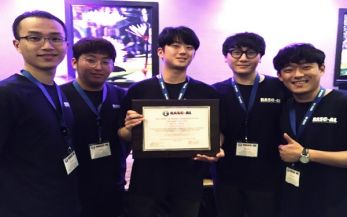
Winning Best in Theme Award in NASA RASC-AL
〈 KAIST team of the Department of Aerospace Engineering poses after winning the Best in Theme Award in NASA's RASC-AL) 〉 〈 Prof. Jaemyung Ahn 〉 A students team from the Department of Aerospace Engineering won the Best in Theme Award for moon exploration system design at Revolutionary Aerospace Systems Concepts - Academic Linkage (RASC-AL), an aerospace mission system design competition organized by NASA in the USA. The KAIST team, consisting of Jaeyoul Ko, Jongeun Suh, Juseong Lee, Sukmin Choi, and Eunkwang Lee, and supervised by Professor Jaemyung Ahn, competed as a joint team with Texas Tech University and the Royal Melbourne Institute of Technology in Australia, The joint team was selected as one of the 14 finalists after two preliminary rounds. The finals of RASC-AL Forum took place from May 30 to June 3 in Florida. The team received the top prize with their design entitled ‘Earth to Lunar Interchangeable Transportation Environment (ELITE) for Logistics Delivery Systems’, one of the four themes of the competition. Since 2002, RASC-AL competitions, managed by NASA, have been held with themes on innovative aerospace system and missions, in which world-class undergraduate and graduate students have participated. This year’s themes were ▲ Lightweight Exercise Suite ▲ Airlock Design ▲ Commercially Enabled LEO/Mars Habitable Module and ▲ Logistics Delivery System. Moon exploration requires a great deal of time and supplies. The KAIST team has been researching supply delivery systems in space for long-term manned moon exploration with their joint team for the last eight months. In particular, incidents can occur during the initial stages of long-term manned moon exploration missions that are unpredictable during system design and planning. Therefore, to cope with such unpredictability in the mission, the KAIST team deduced a system and an operational concept with increased flexibility to maximize the cost effectiveness of the supply transport. The spacecraft was divided into propulsion and transport modules based on their functionalities, and can allow the flexibility by switching the transport module according to the demands of the moon base. The operational flexibility and cost effectiveness are further increased by introducing multiple departure orbits from the Earth (e.g. low Earth orbit vs. geosynchronous Earth orbit) enabled by utilization of various launch vehicles. Professor Ahn, the advisor for the team, said, “I am proud of the students who collaborated with the international joint teams and achieved great result.” He continued, “I believe this to be the result of continuous efforts and initiatives of the department for system design-centered education. We will keep providing high-quality system design and education through various opportunities such as international cooperation in design education.”
-

Face Recognition System “K-Eye” Presented by KAIST
Artificial intelligence (AI) is one of the key emerging technologies. Global IT companies are competitively launching the newest technologies and competition is heating up more than ever. However, most AI technologies focus on software and their operating speeds are low, making them a poor fit for mobile devices. Therefore, many big companies are investing to develop semiconductor chips for running AI programs with low power requirements but at high speeds. A research team led by Professor Hoi-Jun Yoo of the Department of Electrical Engineering has developed a semiconductor chip, CNNP (CNN Processor), that runs AI algorithms with ultra-low power, and K-Eye, a face recognition system using CNNP. The system was made in collaboration with a start-up company, UX Factory Co. The K-Eye series consists of two types: a wearable type and a dongle type. The wearable type device can be used with a smartphone via Bluetooth, and it can operate for more than 24 hours with its internal battery. Users hanging K-Eye around their necks can conveniently check information about people by using their smartphone or smart watch, which connects K-Eye and allows users to access a database via their smart devices. A smartphone with K-EyeQ, the dongle type device, can recognize and share information about users at any time. When recognizing that an authorized user is looking at its screen, the smartphone automatically turns on without a passcode, fingerprint, or iris authentication. Since it can distinguish whether an input face is coming from a saved photograph versus a real person, the smartphone cannot be tricked by the user’s photograph. The K-Eye series carries other distinct features. It can detect a face at first and then recognize it, and it is possible to maintain “Always-on” status with low power consumption of less than 1mW. To accomplish this, the research team proposed two key technologies: an image sensor with “Always-on” face detection and the CNNP face recognition chip. The first key technology, the “Always-on” image sensor, can determine if there is a face in its camera range. Then, it can capture frames and set the device to operate only when a face exists, reducing the standby power significantly. The face detection sensor combines analog and digital processing to reduce power consumption. With this approach, the analog processor, combined with the CMOS Image Sensor array, distinguishes the background area from the area likely to include a face, and the digital processor then detects the face only in the selected area. Hence, it becomes effective in terms of frame capture, face detection processing, and memory usage. The second key technology, CNNP, achieved incredibly low power consumption by optimizing a convolutional neural network (CNN) in the areas of circuitry, architecture, and algorithms. First, the on-chip memory integrated in CNNP is specially designed to enable data to be read in a vertical direction as well as in a horizontal direction. Second, it has immense computational power with 1024 multipliers and accumulators operating in parallel and is capable of directly transferring the temporal results to each other without accessing to the external memory or on-chip communication network. Third, convolution calculations with a two-dimensional filter in the CNN algorithm are approximated into two sequential calculations of one-dimensional filters to achieve higher speeds and lower power consumption. With these new technologies, CNNP achieved 97% high accuracy but consumed only 1/5000 power of the GPU. Face recognition can be performed with only 0.62mW of power consumption, and the chip can show higher performance than the GPU by using more power. These chips were developed by Kyeongryeol Bong, a Ph. D. student under Professor Yoo and presented at the International Solid-State Circuit Conference (ISSCC) held in San Francisco in February. CNNP, which has the lowest reported power consumption in the world, has achieved a great deal of attention and has led to the development of the present K-Eye series for face recognition. Professor Yoo said “AI - processors will lead the era of the Fourth Industrial Revolution. With the development of this AI chip, we expect Korea to take the lead in global AI technology.” The research team and UX Factory Co. are preparing to commercialize the K-Eye series by the end of this year. According to a market researcher IDC, the market scale of the AI industry will grow from $127 billion last year to $165 billion in this year. (Photo caption: Schematic diagram of K-Eye system)

